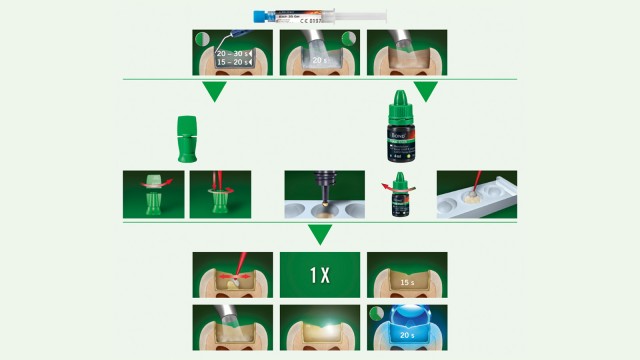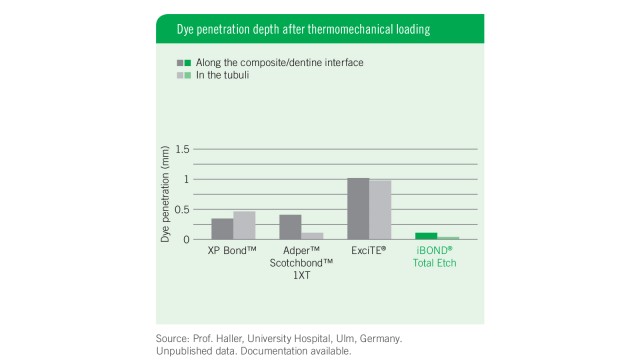iBOND Total Etch Bottle
Overview
iBOND Total Etch is the light curing Etch & Rinse (2-Step) bonding system. It shows how easy and convenient bonding it is to work with the proven Total Etch technique.
Etch & Rinse 2-step adhesive impresses with easy handling through application in only one step.
Benefits
iBOND® Total Etch – for a stable bond
- Bond strength and desensitisation: With iBOND Total Etch, you achieve the greatest possible desensitisation. It offers high reliable bond strength, impressive marginal quality and an optimised overall system through nanofiller. This has been verified by universities and dentists around the world.
- One step: iBOND Total Etch is applied in just one step after etching with iBOND Etch; laborious agitation is no longer necessary. A shiny surface, a sign of effective cross-linking of adhesive and tooth surface, is easily achieved by air drying.
- Homogeneous layer: Due to its optimised consistency, iBOND Total Etch creates a homogeneous adhesive layer on the dentine and enamel – the foundation for outstanding, long-lasting results.
- Stable: The excellent stability of iBOND Total Etch ensures that it can be stored at room temperature; no refrigeration is necessary.
Good to know

Indications
Tried and tested, and rated good.
iBOND Total Etch – Dentists in Europe have already tested and rated* iBOND Total Etch.

- Adhesive bonding of direct composites and composite restorations
- Adhesive bonding of indirect laboratory fabricated ceramic and compomer restorations
- Treatment of hypersensitive tooth regions
| Features | iBOND Total Etch | iBOND Universal | ||||||||||||
|---|---|---|---|---|---|---|---|---|---|---|---|---|---|---|
| Etch&Rinse, Selective Etch, Self Etch | Only etch&rinse | X | ||||||||||||
| Direct Restorations | X | X | ||||||||||||
| Indirect Restorations | X | X | ||||||||||||
| Compatible with Self-, Dual- and Light Cure Materials without activator | X | X | ||||||||||||
| Bonding to silica based ceramics without primer | - | -* | ||||||||||||
| Bonding to ZrO2 and metal without primer | - | X | ||||||||||||
Applications
iBOND Total Etch – Step-by-step application

Science
FAQ
What is the difference between the bonding generations?
- In the etch & rinse 3-step systems type I (4th generation) the total-etch technique is used, enamel and dentine are etched. Primer and bonding agent are included as separate liquids.
- The etch & rinse 2-step systems type II (5th generation) represents the combination of the last two steps of the 4th generation. Primer and bonding agent are available in one bottle. Processing is comparable to that of 4th generation systems with one step less.
- The self-etch 2-step systems type III (6th generation) includes self-conditioning primers or self-conditioning bonding agents to be mixed. The shortcomings of previous generations with regard to conditioning / wet-bonding / hybrid layer formation are avoided.
- The self-etch 1-step systems type IV (7th generation) includes all-in-one adhesives. Etching, priming and bonding are accomplished with only one bottle.
What is meant by total-etch?
The term total etch is used for simultaneous etching of enamel and dentine with e.g. phosphoric acid to remove the smear layer and to obtain micro-porosities for the integration of the bonding agent. The etching always starts on the enamel, then the dentine is also involved. Enamel is etched for 20 seconds, dentine for 15 seconds. Excessive etching can cause hypersensitivity and incomplete hybrid layers.
The term “Total Etch” is also used as a synonym for ("Etch & Rinse" 2-step) 5th generation adhesives, particularly in the English-speaking countries. This was why we have named our product iBOND Total Etch accordingly.
What is meant by wet/moist bonding?
This term describes the following specialised concept: The exposed collagen fibre structure still contains some water and is not dried out completely after etching. Only excess water is removed by air blowing. The water in the intrafibrillary spaces remains and protects them to avoid collapse of the collagen fibres and a consequent reduction of penetration of applied adhesives.
What are the differences GLUMA CB, GLUMA CB + Desensitiser and iBOND Total Etch?
iBOND Total Etch is the new 5th generation Etch&Rinse 2-step (1-bottle) adhesive from Kulzer with improved nano-based formula. iBOND Total Etch is the consequent further development of GLUMA CB & GLUMA CB + Desensitiser. Application of just one layer primes, bonds and desensitises in a single step. For this reason, it combines high bond strength, improved marginal sealing and desensitizing effect with a fast and convenient application.
How many applications can I get from a 4ml? iBOND Total Etch bottle?
Similar to iBOND Self Etch, you get around 50 applications out of an iBOND Total Etch bottle
Can I leave a bottle of iBOND Total Etch? outside the refrigerator and if so, for how long?
In general iBOND Total Etch can be stored outside the refrigerator (max. 25° C), but it is for sure possible to store iBOND Total Etch also in the refrigerator if this is prefered by the customer
Do I have to shake the bottle iBOND Total Etch prior to use?
No, the iBOND Total Etch bottle has not to be shaken before use.
Processing time of iBOND Total Etch: 3 - 5 minutes?
Just like any other bonding material, iBOND Total Etch contains solvents. Since iBOND Total Etch is ethanol-based the composition and the efficiency change when the material has been poured out of the bottle quite some time before (longer than 3 - 5 minutes). Close the bottle after use to avoid any evaporation of ethanol.
How long can I use iBOND Total Etch from a single dose after opening it?
3 to 5 minutes.
Is it necessary to agitate the? iBOND Total Etch layer after applying?
No, agitation is not required and not necessary.
If I have to apply only one coat of iBOND Total Etch, do I need less material than with GLUMA CB + Desensitizer for a restoration?
Theoretical spoken – yes, less material is necessary, but usually customers use in general more drops, so that the savings of material, do not have practical relevance.
Should iBOND Total Etch be applied on uncut enamel?
Yes, this is possible because using iBOND Total Etch is in both cases possible uncut and cut enamel. Because of the fact that the etching process is done separately before applying iBOND Total Etch on cut or uncut enamel.
Should iBOND Total Etch be applied on sclerotic dentin?
Yes, because the etching process is done separately any way, before applying iBOND Total Etch on sclerotic dentin.
How many seconds does it take to cure iBOND Total Etch with a halogen and LED light?
20 seconds.
Can iBOND Total Etch be light cured by LED?
Yes, iBOND Total Etch is compatible with LED. Use of LED needs 100% of recommended curing time (20 seconds)
Can a different applicator be used?
Yes. iBOND Total Etch contains all components. You can use any other applicator that is ethanol resistant.
How thick are the adhesive layer and the hybrid layer of iBOND Total Etch in comparision with iBOND self Etch?
iBOND Self Etch
Adhesive layer: 3-5 µm
Hybrid layer: 0.3-0.5 µm
The hybrid layer of iBOND Self Etch corresponds to the demineralization depth
Total-Etch Systems
Adhesive layer: 5-20 µm
Hybrid layer: 1.5-3 µm
Demineralization depth: 10-50 µm
Can you describe the testing done to assure there will not ?be any staining issues?
According to a study done by Prof. Haller, University of Ulm Germany, iBOND Total Etch received excellent results regarding staining marginal quality. In a comparision with Adper Scotchbond 1 XT, Excite and XP Bond, iBOND Total Etch was the top of class product in this matter.
Why is iBOND Total Etch convenient in handling and application?
iBOND Total Etch needs to be applied in only one layer and the air drying of the layer is quite easily as the material remains stable in the cavity, there is no agitation necessary.
What is the percentage of nano-fillers in iBOND Total Etch?
The percentage of nano-fillers in iBOND Total Etch is between 1% - 5 %.
How can iBOND Total Etch desensitize?
iBOND Total Etch contains glutardialdehyde that close the dentin tubuli internally and operates in the same way than GLUMA Desensitizer.
How long is the integrated desensitization effect maintained?
Desensitization of restorations is permanent just like with the pure desensitizer or GLUMA Comfort Bond + Desensitizer. Desensitization of non-filled tooth areas is maintained for 6 month to one year, depending on patient-specific erosion factors.
Does iBOND Total Etch replace the use of desensitizers?
Tooth surfaces treated with iBOND Total Etch do not have to be treated separately with desensitizers. Nevertheless a separately desensitization only with GLUMA Desensitizer is possible.
Can I combine iBOND Total Etch with self-and dual-curing luting materials?
iBOND Total Etch can be used in combination with light and dual curing luting materials in case of indirect restorations.
Can I apply iBOND Total Etch on calcium hydroxide?
Yes. Only some µm of the calcium hydroxide surface will be slightly dissolved.
iBOND Total Etch as direct capping material?
Numerous studies recommend not to use the material for this purpose. Kulzer does not recommend iBOND Total Etch for direct pulp capping. This should be done traditionally.
Is the use of rubber dam required?
A contamination check is essential. If this is ensured, the use of rubber dam may not be required in certain cases, decided by the dentist. Nevertheless Kulzer recommends to use rubber dam in any case. Please bear in mind that iBOND Total Etch is an slight acidic product and unintended mucous membrane contact may result in superficial burns. This can be seen in a whitish reversible discoloration of the mucous membrane.
Which influence do the solvents have?
The technique to be used depends on the solvent. In the case of acetone-based total-etch systems the bonding agent must be rather applied on wet, etched dentin. Water-based systems prefer drier dentin. Ethanol takes a position in the middle and is applied on moist dentin. Prior to polymerization, solvents must always be dried with air from the bonding agent. When using acetone, this is relatively simple, whereas water-based systems need to be "dried" longer. Incomplete evaporation causes deficient polymerization and failures. Summarizing these facts, we do recommend using a moist / wet bonding technique regarding the use of iBOND Total Etch.
Why does iBOND Total Etch contains HEMA?
HEMA is a hydrophilic monomer that is a good wetting agent and penetrates easily into the tooth surface. One of the drawbacks with HEMA is, that it firmly retains water in adhesives, from where it is hardly removed by air-drying. The self-etching adhesive iBOND Self Etch contains a high amount of water. Therefore iBOND Self Etch is HEMA-free and rather contains 4-META in a high amount. 4-META is hydrophilic and penetrates easily into the tooth surface too. Additionally it is acidic and responsible for the etching process.
There is 4-META in iBOND Total Etch too but in a low amount. It functions not as wetting and acidic monomer but supports adhesion by bonding chemically to collagen fibers. Thus HEMA is necessary in iBOND Total Etch as additional wetting and penetrating ingredient. However iBOND Total Etch contains only a little amount of water so the removing of water can be achieved easily although HEMA is inside.
What is the role of Glutaraldehyde?
iBOND Total Etch contains Glutaraldehyde. This ingredient is able to coagulate proteins and acts as desensitizing agent by plugging open tubules with coagulated proteins. Additionally it is able to bond to crosslink the collagen fiber to prevent a collapse of the collagen scaffold.
Should iBOND Total Etch rubbed upon application?
No. The etching pattern that was created by etching enamel with phosphoric acid might be destroyed by rubbing. Subsequently the reliable bonding to enamel might be affected negatively.
What is the amount of solvent in iBOND Total Etch?
iBOND Total Etch contains ethanol and water as solvents. The total amount of solvents is approx. 40 %.










